Jezero (crater)
Jezero (/ˈjɛzəroʊ/ YEZ-ə-roh or /ˈdʒɛzəroʊ/ JEZ-ə-roh)[1] is a crater on Mars located at 18.38°N 77.58°E[2] in the Syrtis Major quadrangle. The diameter of the crater is about 49.0 km (30.4 mi). Thought to have once been flooded with water, the crater contains a fan-delta deposit rich in clays.[3] The lake in the crater was present when valley networks were forming on Mars. Besides having a delta, the crater shows point bars and inverted channels. From a study of the delta and channels, it was concluded that the lake inside the crater probably formed during a period in which there was continual surface runoff.[4]
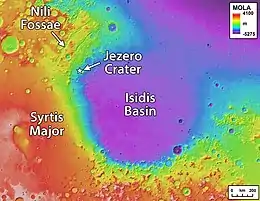 Jezero crater on the edge of the Isidis basin | |
| Planet | Mars |
|---|---|
| Coordinates | 18.38°N 77.58°E |
| Quadrangle | Syrtis Major quadrangle |
| Diameter | 49.0 km (30.4 mi) |
| Eponym | Jezero, Bosnia and Herzegovina |
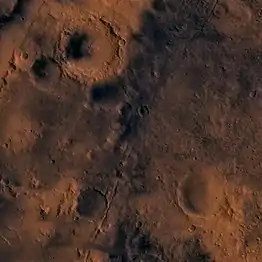
In 2007, following the discovery of its ancient lake, the crater was named for Jezero[5] in Bosnia and Herzegovina, one of several eponymous towns in the country.[6] In several Slavic languages, including Czech, Bosnian, Croatian, Serbian, Montenegrin, and Slovene, the word jezero means 'lake' and is correctly pronounced ['je.ze.ro].
In November 2018, it was announced that Jezero had been chosen as the landing site for the rover Perseverance of NASA's Mars 2020 mission.[7][8][9] In November 2020, evidence of boulder falls was found on the slopes of the delta deposits that the rover is planned to explore, on the wall of Jezero itself as well as on the wall of a small (2-kilometre diameter) crater on the floor of Jezero.[10]
Crater
Life may have developed in the crater since it is believed the lake was long-lived; the delta may have required a period of 106–107 years to form.[11] Clay minerals have been detected in and around the crater.[12][13][14] The Mars Reconnaissance Orbiter identified smectite clays.[15] Clays form in the presence of water, so this area probably once held water and maybe life in ancient times. The surface in places is cracked into polygonal patterns. Such shapes often form when clay dries out. These patterns can be seen in the image below. The image shows a channel that carried water and sediments into Jezero crater.[2]
Researchers described in a paper, released in March 2015, how an ancient Martian lake system existed in Jezero Crater. The study advanced the idea that water filled the crater at least two separate times.[16] There are two channels on the northern and western sides of the crater that probably supplied it with water; each of these channels has a delta-like deposit where sediment was carried by water and deposited in the lake.[17] Craters of a given diameter are expected to have a certain depth; a depth less than expected means sediment has entered the crater.[18] Calculations suggest that the crater may hold about one kilometer of sediments. Most of the sediments may have been brought in by channels.[11]
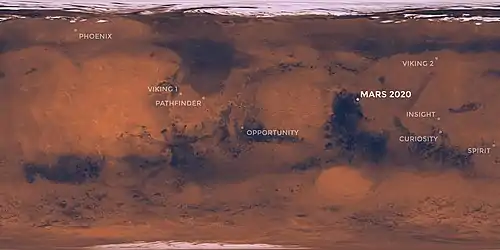
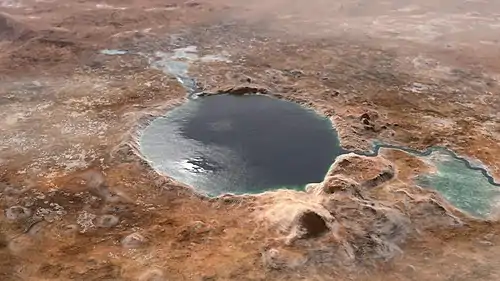



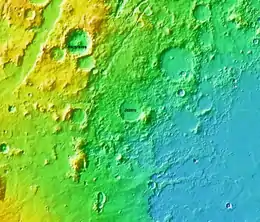

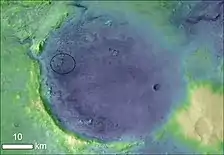


Mars 2020 mission

Jezero crater, once considered a site for the Mars Science Laboratory, was later proposed as a landing site for the Mars 2020 rover mission.[19][21] In early 2017 it was selected to be among the top three candidate sites for the landing, along with Northeast Syrtis, 30 km to the southwest.[22]
A primary aim of the Mars 2020 mission is to search for signs of ancient life. It is hoped that a later mission could then return samples from sites identified as probably containing remains of life. To safely bring the craft down, a 12-mile (20 km) wide, smooth, flat circular area is needed. Geologists hope to examine places where water once ponded.[23] They would like to examine sediment layers.
In November 2018, Jezero crater was selected as the target landing site for the Mars 2020 rover mission.[24]
Interactive Mars map


See also
- Astrobiology – Science concerned with life in the universe
- Climate of Mars – Climate patterns of the terrestrial planet
- Composition of Mars – Branch of the Geology of Mars
- Exploration of Mars
- Geology of Mars – Scientific study of the surface, crust, and interior of the planet Mars
- Impact crater – Circular depression on a solid astronomical body formed by a hypervelocity impact of a smaller object
- Inverted relief – Landscape features that have reversed their elevation relative to other features
- Lakes on Mars – Overview about the presence of lakes on Mars
- List of craters on Mars – Wikipedia list article
- Mars landing
- Water on Mars – Study of past and present water on Mars
References
- Lakdawlla, Emily (20 November 2018). "We're going to Jezero!". Planetary Society. Retrieved 9 December 2018.
- Wray, James (6 June 2008). "Channel into Jezero Crater Delta". NASA. Retrieved 6 March 2015.
- Muir, Hazel. "Prime landing sites chosen for biggest Martian rover". Retrieved 20 November 2018.
- Goudge, T.; et al. (2017). Stratigraphy and Evolution of Delta Channel Deposits, Jezero Crater Mars (PDF). Lunar and Planetary Science 48 (2017). 1195.pdf.
- "4th July celebration at USA Embassy in Sarajevo / Pro-ruski savez na (ne)djelu: Dodik i Čović odbili doći na proslavu Dana nezavisnosti SAD-a". slobodna-bosna.ba (in Bosnian). 3 July 2019. Retrieved 3 July 2019.
- "Planetary Names: Crater, craters: Jezero on Mars". planetarynames.wr.usgs.gov. Retrieved 14 December 2018.
- Chang, Kenneth (28 July 2020). "How NASA Found the Ideal Hole on Mars to Land In - Jezero crater. the destination of the Perseverance rover, is a promising place to look for evidence of extinct Martian life". The New York Times. Retrieved 28 July 2020.
- Chang, Kenneth (19 November 2018). "NASA Mars 2020 Rover Gets a Landing Site: A Crater That Contained a Lake - The rover will search the Jezero Crater and delta for the chemical building blocks of life and other signs of past microbes". The New York Times. Retrieved 21 November 2018.
- Wall, Mike (19 November 2018). "Jezero Crater or Bust! NASA Picks Landing Site for Mars 2020 Rover". Space.com. Retrieved 20 November 2018.
- Sinha, R.K.; et al. (2020). "Boulder fall activity in the Jezero Crater, Mars". Geophysical Research Letters (2020). doi:10.1029/2020GL090362.
- Schon, S.; Head, J.; Fassett, C. (2012). "An overfilled lacustrine system and progradational delta in Jezero crater, Mars: Implications for Noachian climate". Planetary and Space Science. 67: 28–45.
- Bibring, J.; et al. (2006). "Global mineralogical and aqueous Mars history derived from OMEGA/Mars Express data". Science. 312: 400–404.
- Mangold, N.; et al. (2007). "Mineralogy of the Nili Fossae region with OMEGA/Mars Express data: 2. Aqueous alteration of the crust". Journal of Geophysical Research. 112: E08S04. doi:10.1029/2006JE002835.
- Poulet, F.; et al. (2005). "Phyllosilicates on Mars and implications for early Martian climate". Nature. 438. doi:10.1038/nature04274.
- Murchie, S.; et al. (2009). "A synthesis of Martian aqueous mineralogy after 1 Mars year of observations from the Mars Reconnaissance Orbiter" (PDF). Journal of Geophysical Research. 114 (E2): E00D06. Bibcode:2009JGRE..114.0D06M. doi:10.1029/2009JE003342.
- "Ancient Martian lake system records two water-related events". ScienceDaily. 25 March 2015. Retrieved 20 November 2018.
- "Ancient Martian Lake System Records Two Water-related Events - SpaceRef". spaceref.com. Retrieved 20 November 2018.
- Garvin, J., S. Sakimoto, J. Frawley (2003). Craters on Mars: Global geometric properties from gridded MOLA topography. Sixth International Conference on Mars. Abstract no. #3277.CS1 maint: multiple names: authors list (link)
- Staff (4 March 2015). "PIA19303: A Possible Landing Site for the 2020 Mission: Jezero Crater". NASA. Retrieved 7 March 2015.
- Goudge, Timothy A.; Mustard, John F.; Head, James W.; Fassett, Caleb I.; Wiseman, Sandra M. (6 March 2015). "Assessing the Mineralogy of the Watershed and Fan Deposits of the Jezero Crater Paleolake System, Mars". Journal of Geophysical Research. 120 (4): 775. Bibcode:2015JGRE..120..775G. doi:10.1002/2014JE004782. S2CID 29382260.
- Caleb Fassett, Bethany Ehlmann, Jim Head, Scott Murchie, Jack Mustard, Sam Schon. "Jezero Crater Lake: Phyllosilicate-bearing sediments from a Noachian valley network as a potential MSL landing site" (PDF). Retrieved 19 December 2020.CS1 maint: multiple names: authors list (link)
- Witze, Alexandra (11 February 2017). "Three sites where NASA might retrieve its first Mars rock". Nature. Bibcode:2017Natur.542..279W. doi:10.1038/nature.2017.21470. Retrieved 26 February 2017.
- Staff (2010). "The Floods of Iani Chaos". NASA. Retrieved 7 March 2015.
- Mandelbaum, Ryan F. "NASA's Mars 2020 Rover Will Land in Jezero Crater". Gizmodo. Retrieved 20 November 2018.
Further reading
- Ehlmann, B.L.; Mustard, John F.; Fassett, Caleb I.; Schon, Samuel C.; Head Iii, James W.; Des Marais, David J.; Grant, John A.; Murchie, Scott L. (2008). "Clay minerals in delta deposits and organic preservation potential on Mars" (PDF). Nature Geoscience. 1 (6): 355–358. Bibcode:2008NatGe...1..355E. doi:10.1038/ngeo207.
- Schon; et al. (2008). Meander Loops and Point Bar Sequences - Evidence of a Stable Delta Plain Environment in Jezero crater (PDF). Lunar and Planetary Sciences conference.
External links
- NASA – Jezero Crater – DataSheet (14 January 2017)
- NASA – Jezero Crater – Workshop Images/Details (4 August 2015)
- Video – FlyOver bw (01:20) and color (02:20) (SDoran; 21 April 2017)
- Video – Mars 2020 Site News (01:00) (NASA; 19 November 2018)
- Video – Mars 2020 Site News (00:50) (MSN; 19 November 2018)
- Video – Mars 2020: Jezero crater flyover (02:13) (NASA; 13 December 2018)
